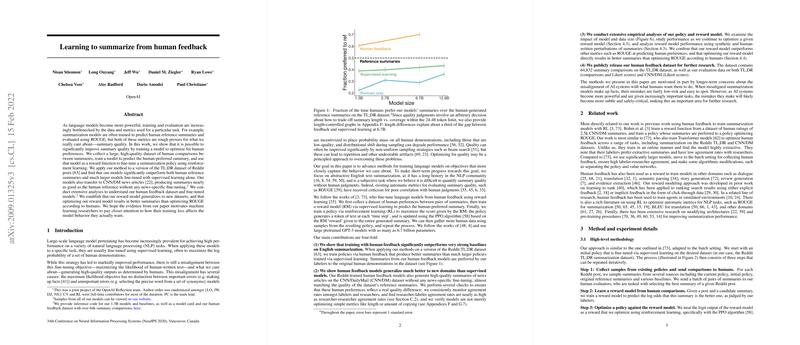Essay on the Paper "Learning to summarize from human feedback"
The paper "Learning to summarize from human feedback" presents a methodology for improving the quality of summarization by training a LLM to align with human preferences. This approach addresses limitations in existing summarization models, which typically optimize metrics such as ROUGE, often criticized for their weak correlation with human judgment.
Methodological Approach
The central methodology involves training a reward model (RM) based on human feedback and then employing reinforcement learning (RL) to optimize a summarization policy using this RM. The process comprises three main steps:
- Data Collection: The authors collect a substantial dataset of human preferences by asking labelers to compare pairs of summaries and choose the better one.
- Reward Model Training: This dataset is used to train an RM to predict human preferences.
- Policy Optimization: The reward model assigns rewards to summaries generated by the summarization policy, which is fine-tuned using the Proximal Policy Optimization (PPO) algorithm.
The dataset, drawn from Reddit's TL;DR posts, allows the model to learn from a wide variety of summarization styles and topics. Importantly, the authors also demonstrate the transferability of their models by evaluating them on the CNN/DM news dataset without additional fine-tuning, achieving comparable performance to human reference summaries.
Numerical Results and Analysis
The authors report substantial improvements in summary quality, evidenced by human evaluations. The 1.3B parameter model optimized with human feedback outperforms a 10x larger supervised model, achieving preference rates of 61% versus 43% over reference summaries. The 6.7B model further improves preference rates, underscoring the scalability of training with human feedback.
The analysis of summary quality across dimensions such as coverage, accuracy, coherence, and overall quality revealed that human feedback models consistently score higher in every category compared to supervised baselines. For example, on the criterion of coverage, the 6.7B human feedback model receives commendable ratings, indicative of its comprehensive grasp of source content.
Implications for Future Research
The implications of this paper extend both practically and theoretically within the AI domain. Practically, the approach offers a promising path for tasks where human-like output quality is paramount but hard to quantify with automatic metrics. Theoretically, the interplay between human feedback and machine learning aligns with broader trends in AI towards more interpretable and user-aligned models.
The transferability demonstrated on the CNN/DM dataset suggests that models trained with human feedback are not excessively specialized to one type of data and retain generalization capabilities. This aligns with longer-term goals of AI alignment where models must operate reliably across varied and unforeseen circumstances.
Prospects and Challenges
Future research could expand this methodology to other domains beyond text summarization, such as dialogue generation, machine translation, and even more complex, open-ended tasks. The techniques' strengths lie in their ability to align models more closely with human preferences, potentially enhancing their safety and reliability in critical applications.
However, the approach also presents challenges. The acquisition of high-quality human feedback is resource-intensive and requires rigorous quality control to ensure labeler consistency and model fidelity to human judgments. Moreover, the reliance on human preferences necessitates careful consideration of the broader impacts and ethical dimensions of deploying such models, particularly in sensitive applications.
Conclusion
The paper "Learning to summarize from human feedback" is a significant contribution to the field of NLP, presenting a robust methodology for leveraging human input to optimize summarization models. By empirically demonstrating that models trained with human feedback can surpass those optimized with traditional metrics, it sets a precedent for developing more human-aligned AI systems. Future work in this direction promises both improved performance in a variety of tasks and greater alignment of AI systems with human values and preferences.
